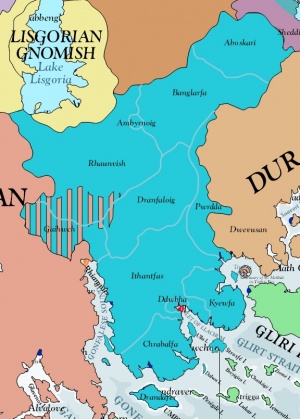Gonfalese Language
The Gonfalese Language originated from Medibgösk in the thirteenth century when Medibgö sent forth several colonizing missions to the Rhaunve River Valley. The is the prevalent language of both Gonfaloys, Ambrasia, the Magdalan Principalities of Amosgire, Flamander, and Ygdafyl, and a widely spoken language of the Asbardian province of Flisbardy. There is some degree of mutual intelligibility between Gonfalese and Medibgóëse Language and it is easy for Gonfalese speakers to acquire the language of Medibgö. Gonfalese was once spoken to a significant minority in Breomarch (eastern Esphagonia), but native speakers have become extremely rare in the past two or three centuries as the inhabitants have adopted Asbardian. There is no central authority for standard Gonfalese as it is spoken in several nations.
Early History
In the thirteenth century after Salmakhamer, Medibgö sent several groups of colonists to the Rhauve River Valley to gain control over this rich agricultural land and reduce population in the skynesses. At this time, the power of the Yophenthean Successor States in Pytharnia had waned and could not offer the Medibgóëse organized resistance. The Gonfalese language is thus about fifteen centuries old and younger than the neighboring human languages of Asbardian, Dúrandworese, and Pytharnian. Late Yophenthean was spoken in the lands where Gonfalese prevailed and thus Gonfalese has many borrowings from the Ambrasian Language in contrast to Medibgóëse that has fewer which are mostly limited to law and religion. Gonfalese derived from early Middle Medibgösk. Gonfalese itself is divided into two periods, early Gonfalese (1300 to 1900) and Modern Gonfalese (1900 to present day). Gonfalese borrows nearly half its modern lexicon (vocabulary) from the now extinct Ambrasian Language. Numerous idioms and borrowed language structures also exist in Gonfalese.
Dialects of Gonfalese
Despite the relatively small area in which Gonfalese is spoken, there are at least twelve academically recognized dialects. The prestige dialects are Rhaunvish-Dranfaloig and proper Gonfalese is based upon these dialects. The Ddwbha dialect has a high number of speakers since it is spoken in the populous city of the same to which it is geographically limited. The Drandafer Dialect is often considered the most rustic. The sparsely spoken Aboskari Dialect carries an ominous sound to the Gonfalese ear as this dialect is spoken in the Amosgire Hills. The Pwrdda dialect is spoken beyond the hills of Gonfaloy on a strip of land just within the geographic land of Dúrandwor. It suffers from negative prestige as it has some components of the Dúrandworese Language. The Ambyrnoig dialect is spoken in the city Amyrn and the immediate vicinity. The Ambyrnoig dialect has some positive prestige due the perceived education level of citizens of Amyrn mixed with the sense of stuffy formality and religious observance. The largest divide is between Dranfaloig and Ithantfas, where the northern Dialects of Rhaunvish (Rhownfioig), Dranfaloig, Gaihwch, Ambyrnoig, Banglarfa, and Aboskari are considered as a whole somewhat more prestigious than the southern dialects of Ithantfas, Pwrdda, Ddwbha, Kyewfa, Chrabalfa, and Dradafer. The Asbardian province of Flisbardy has a large minority of Asbardian speakers who speak the Flisbardian dialect of Asbardian. The Gonfalese speakers have a slim majority. The Gaihwch Dialect of Gonfalese is spoken in the western end of the province also further south in the Principality of Gonfaloy. Gaihwch is a gateway for many loanwords of Asbardian origin that sometimes make it into the greater Gonfalese Language.
Lexicon
- FF
- ffarg prep against, opposite of
- U
- ugdais adj lame
See Also
- Gonfaloy
- Languages of Pytharnia
- List of Gonfalese Personal Names
- Medibgóëse Language
- Settlement of Gonfaloy
| This article is a stub. It requires further development by the creator. |
